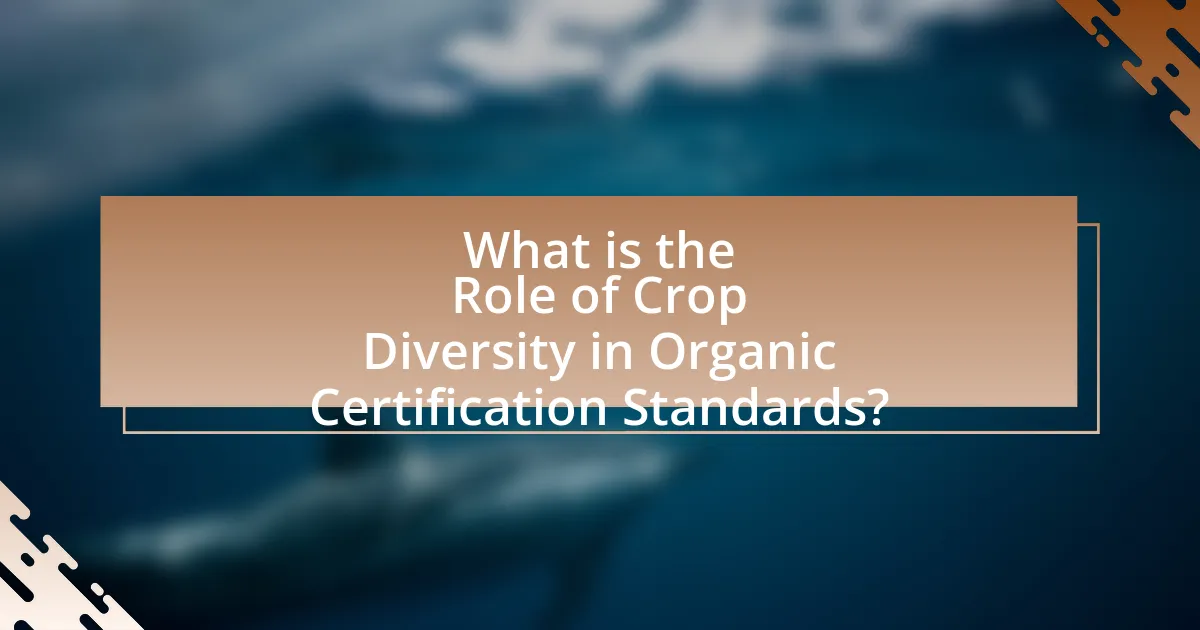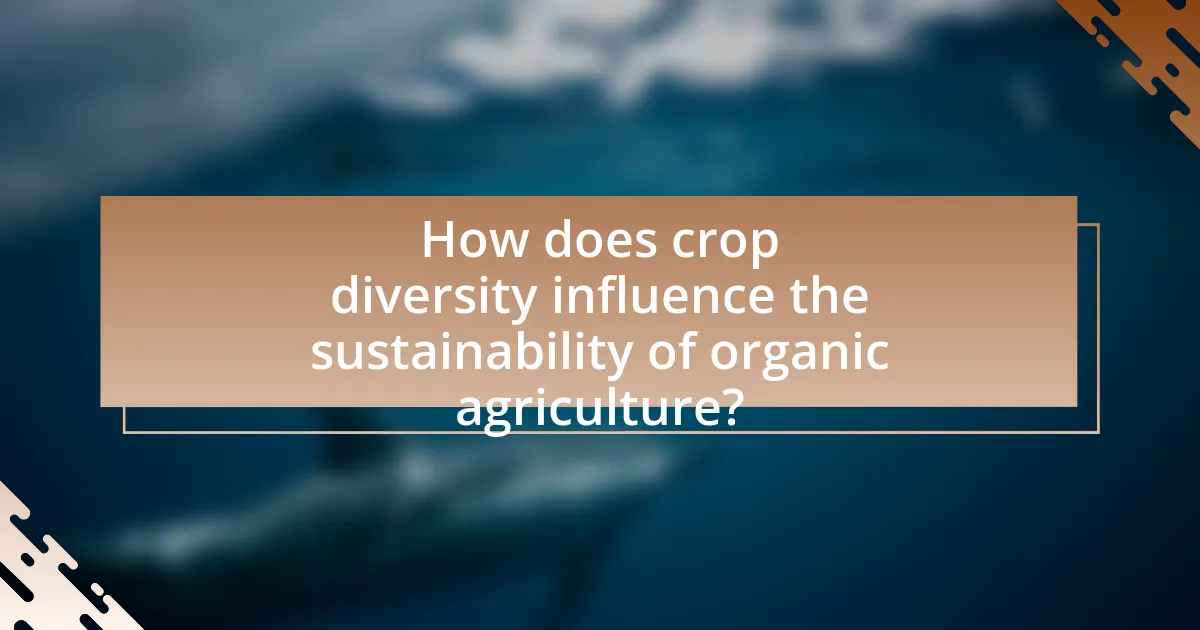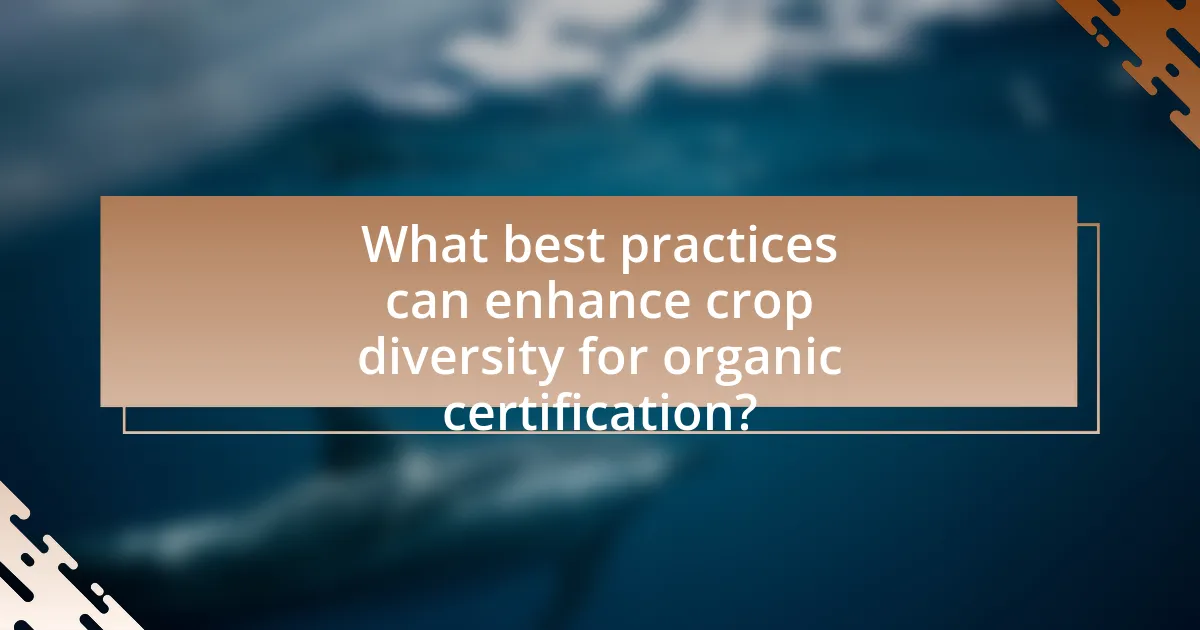Crop diversity is a fundamental aspect of organic certification standards, significantly contributing to ecological balance and soil health. The article explores how diverse cropping systems enhance organic farming practices by improving pest management, increasing resilience against diseases and climate variability, and promoting sustainable agricultural methods. It outlines the key principles of organic farming related to crop diversity, the specific criteria set by certification standards, and the challenges farmers face in implementing diverse cropping systems. Additionally, it discusses best practices such as crop rotation and intercropping, the role of agricultural extension services, and the long-term benefits of maintaining crop diversity for organic farmers.

What is the Role of Crop Diversity in Organic Certification Standards?
Crop diversity plays a crucial role in organic certification standards by promoting ecological balance and enhancing soil health. Organic certification requires farmers to implement practices that support biodiversity, which helps in pest management and reduces the reliance on synthetic inputs. For instance, the USDA National Organic Program emphasizes the importance of crop rotation and intercropping, which are practices that increase diversity and contribute to sustainable farming systems. Research indicates that diverse cropping systems can lead to improved resilience against diseases and climate variability, thereby aligning with the principles of organic agriculture.
How does crop diversity contribute to organic farming practices?
Crop diversity significantly enhances organic farming practices by promoting ecosystem resilience and improving soil health. Diverse crops can reduce pest and disease outbreaks, as a variety of plants can disrupt the life cycles of specific pests, leading to lower reliance on synthetic pesticides. Additionally, crop rotation and intercropping, common practices in organic farming, improve soil structure and nutrient cycling, which are essential for sustainable agriculture. Research indicates that farms with higher crop diversity can yield better overall productivity and stability, as demonstrated in studies showing that polycultures can outperform monocultures in terms of yield stability under varying environmental conditions.
What are the key principles of organic farming related to crop diversity?
The key principles of organic farming related to crop diversity include promoting biodiversity, enhancing ecosystem health, and improving soil fertility. Organic farming emphasizes the cultivation of a variety of crops to create a balanced ecosystem that supports beneficial organisms and reduces pest outbreaks. This diversity helps in nutrient cycling and soil structure improvement, which are essential for sustainable agriculture. Research indicates that farms with higher crop diversity can yield better resilience against climate change and pest pressures, as demonstrated in studies showing that diverse cropping systems can reduce the need for chemical inputs and enhance overall farm productivity.
How does crop diversity enhance soil health in organic systems?
Crop diversity enhances soil health in organic systems by improving soil structure, increasing nutrient availability, and promoting beneficial microbial activity. Diverse crops contribute to a more complex root system, which helps prevent soil erosion and enhances water retention. Additionally, different plants have varying nutrient requirements and root depths, allowing for more efficient nutrient uptake and reducing the risk of nutrient depletion. Research indicates that crop rotation and intercropping can lead to higher soil organic matter and improved soil fertility, as seen in studies conducted by the Rodale Institute, which found that diverse cropping systems can increase soil carbon levels and microbial biomass.
Why is crop diversity important for organic certification?
Crop diversity is important for organic certification because it enhances ecosystem resilience and promotes sustainable agricultural practices. Diverse crops can improve soil health, reduce pest and disease pressures, and increase biodiversity, which are all key principles of organic farming. Research indicates that farms with higher crop diversity can yield better overall productivity and sustainability, as they are less reliant on chemical inputs and more capable of adapting to environmental changes. This aligns with organic certification standards that prioritize ecological balance and resource conservation.
What specific criteria do organic certification standards set for crop diversity?
Organic certification standards require that farms maintain a diverse range of crops to promote ecological balance and reduce pest and disease pressures. Specifically, these standards often mandate the inclusion of multiple crop species and varieties within a given area, which enhances biodiversity and soil health. For instance, the USDA National Organic Program emphasizes crop rotation and intercropping practices, which are essential for maintaining soil fertility and preventing erosion. Additionally, organic standards may specify that farmers must not rely solely on monocultures, as diverse cropping systems are proven to improve resilience against climate variability and pest outbreaks.
How does crop diversity impact pest and disease management in organic farming?
Crop diversity significantly enhances pest and disease management in organic farming by promoting ecological balance and reducing the prevalence of specific pests and pathogens. Diverse cropping systems create habitats for beneficial organisms, such as predators and parasitoids, which help control pest populations naturally. Research indicates that farms with higher crop diversity experience lower pest incidence; for example, a study published in the journal “Agriculture, Ecosystems & Environment” found that diversified systems reduced pest outbreaks by up to 50% compared to monocultures. Additionally, crop rotation and intercropping disrupt pest life cycles and minimize disease spread, further supporting sustainable organic practices.
What challenges does crop diversity face in organic certification?
Crop diversity faces several challenges in organic certification, primarily due to stringent regulations and the need for uniformity in production practices. These regulations often prioritize specific crop varieties that meet established standards, limiting the inclusion of diverse species that may not conform to these criteria. Additionally, the certification process can be costly and time-consuming, discouraging farmers from adopting diverse cropping systems. Research indicates that organic certification bodies may favor monocultures for their ease of management and predictability, which undermines the ecological benefits of crop diversity. Furthermore, the lack of clear guidelines for certifying diverse cropping systems can create confusion and inconsistency in the certification process.
What are the common barriers to implementing crop diversity in organic systems?
Common barriers to implementing crop diversity in organic systems include limited access to diverse seed varieties, lack of knowledge and training among farmers, and economic constraints. Limited access to diverse seed varieties restricts farmers from selecting crops that are best suited for their local conditions, which can hinder the establishment of diverse cropping systems. Additionally, many farmers may lack the necessary knowledge and training to effectively manage diverse crops, leading to challenges in cultivation and maintenance. Economic constraints, such as the higher costs associated with organic farming practices and the initial investment required for diverse crop systems, can further deter farmers from adopting crop diversity. These barriers collectively impede the potential benefits of crop diversity, such as improved resilience and sustainability in organic farming.
How can farmers overcome these challenges to meet certification standards?
Farmers can overcome challenges to meet certification standards by implementing crop diversity strategies that enhance soil health and pest management. By rotating different crops, farmers can improve soil fertility and reduce the risk of pest infestations, which are critical factors in organic certification. Research indicates that diverse cropping systems can lead to a 20-30% increase in yield stability and resilience against climate variability, thus supporting compliance with organic standards. Additionally, farmers can engage in continuous education and training on organic practices, which has been shown to increase adherence to certification requirements.

How does crop diversity influence the sustainability of organic agriculture?
Crop diversity significantly enhances the sustainability of organic agriculture by promoting ecosystem resilience and reducing dependency on chemical inputs. Diverse cropping systems improve soil health, increase biodiversity, and enhance pest and disease management, which are critical for maintaining organic farming standards. Research indicates that farms with higher crop diversity can yield more stable outputs and are less susceptible to climate variability, as demonstrated in studies showing that polycultures can outperform monocultures in terms of productivity and resource use efficiency. Additionally, diverse crops can support beneficial organisms, leading to natural pest control and reduced need for synthetic pesticides, aligning with organic certification requirements.
What role does crop diversity play in promoting biodiversity on farms?
Crop diversity plays a crucial role in promoting biodiversity on farms by enhancing ecosystem resilience and stability. Diverse crops support a wider range of organisms, including beneficial insects, soil microorganisms, and wildlife, which contribute to natural pest control, pollination, and nutrient cycling. Research indicates that farms with higher crop diversity can increase overall species richness and abundance, leading to healthier ecosystems. For instance, a study published in the journal “Agriculture, Ecosystems & Environment” found that polyculture systems, which incorporate multiple crop species, can significantly improve biodiversity compared to monoculture systems. This increased biodiversity not only benefits the environment but also enhances agricultural productivity and sustainability.
How does increased biodiversity affect ecosystem services in organic farming?
Increased biodiversity positively affects ecosystem services in organic farming by enhancing soil health, pest control, and pollination. Diverse crop systems improve soil structure and nutrient cycling, leading to higher fertility and resilience against erosion. For instance, studies show that farms with greater plant diversity can reduce pest populations naturally, decreasing the need for chemical interventions. Additionally, a variety of flowering plants supports a wider range of pollinators, which is crucial for crop yields. Research published in “Agriculture, Ecosystems & Environment” by Tilman et al. (2014) indicates that higher biodiversity in agricultural systems correlates with improved ecosystem functioning and stability, reinforcing the importance of crop diversity in organic farming practices.
What are the long-term benefits of maintaining crop diversity for organic farmers?
Maintaining crop diversity offers organic farmers long-term benefits such as enhanced soil health, increased resilience to pests and diseases, and improved ecosystem services. Diverse cropping systems contribute to soil fertility through varied root structures and organic matter inputs, which can lead to higher yields over time. Research indicates that farms with greater crop diversity experience reduced pest outbreaks, as natural predators thrive in varied environments, thus decreasing the need for chemical interventions. Additionally, diverse crops can improve pollinator habitats and promote biodiversity, which supports overall farm sustainability. Studies have shown that farms practicing crop diversity can achieve up to 20% higher yields compared to monoculture systems, demonstrating the economic viability of this approach.
How can crop diversity improve resilience against climate change?
Crop diversity enhances resilience against climate change by providing a wider range of genetic traits that can withstand varying environmental stresses. This diversity allows for better adaptation to changing conditions, such as drought, pests, and diseases, which are exacerbated by climate change. For instance, studies have shown that diverse cropping systems can yield more stable outputs under adverse conditions compared to monocultures, as different crops respond uniquely to stressors. Additionally, a report by the Food and Agriculture Organization indicates that diverse agricultural systems can improve soil health and ecosystem services, further supporting agricultural resilience in the face of climate variability.
What strategies can organic farmers use to enhance crop diversity in response to climate variability?
Organic farmers can enhance crop diversity in response to climate variability by implementing crop rotation, intercropping, and selecting diverse seed varieties. Crop rotation involves alternating different crops in the same field across seasons, which improves soil health and reduces pest and disease pressure. Intercropping, the practice of growing two or more crops in proximity, can optimize resource use and increase resilience against climate extremes. Additionally, selecting diverse seed varieties allows farmers to choose crops that are better suited to changing climate conditions, thereby increasing overall farm resilience. Research indicates that farms with higher crop diversity can better withstand climate-related stresses, leading to improved yields and sustainability.
How does crop diversity contribute to food security in organic agriculture?
Crop diversity significantly enhances food security in organic agriculture by increasing resilience against pests, diseases, and climate variability. Diverse cropping systems reduce the risk of total crop failure, as different species can thrive under varying conditions and provide a buffer against environmental stresses. Research indicates that farms with higher crop diversity can yield more stable outputs, as seen in a study published in “Agricultural Systems” by Isbell et al. (2015), which found that diverse ecosystems can increase productivity by up to 20% compared to monocultures. This stability is crucial for ensuring a consistent food supply, thereby directly contributing to food security.

What best practices can enhance crop diversity for organic certification?
Implementing crop rotation is a best practice that enhances crop diversity for organic certification. Crop rotation involves alternating different crops in the same area across seasons, which helps improve soil health, reduce pest and disease pressure, and increase biodiversity. Research indicates that diverse cropping systems can lead to higher yields and better resilience against climate variability. Additionally, intercropping, where two or more crops are grown together, can further enhance biodiversity and improve resource use efficiency. Studies show that farms practicing these methods often meet organic certification standards more effectively due to improved ecological balance and reduced reliance on synthetic inputs.
How can farmers effectively implement crop rotation and intercropping?
Farmers can effectively implement crop rotation and intercropping by planning diverse planting schedules that enhance soil health and reduce pest pressure. Crop rotation involves alternating different crops in a specific sequence over time, which helps to break pest and disease cycles, improve soil fertility, and optimize nutrient use. For instance, rotating legumes with cereals can enhance nitrogen levels in the soil, benefiting subsequent crops. Intercropping, on the other hand, involves growing two or more crops simultaneously in the same field, which can maximize space and resources, reduce weed competition, and improve overall yield. Research indicates that intercropping can increase productivity by up to 20% compared to monoculture systems. By integrating these practices, farmers can achieve sustainable agricultural systems that align with organic certification standards, which emphasize biodiversity and ecological balance.
What are the benefits of crop rotation in maintaining soil fertility?
Crop rotation significantly enhances soil fertility by improving nutrient availability and reducing soil erosion. This agricultural practice involves alternating different crops in a specific sequence, which helps to replenish essential nutrients that are depleted by continuous cropping. For instance, legumes, when included in the rotation, fix atmospheric nitrogen into the soil, enriching it for subsequent crops. Research indicates that crop rotation can increase soil organic matter by up to 30%, which is crucial for maintaining soil structure and fertility. Additionally, rotating crops disrupts pest and disease cycles, leading to healthier plants and reduced reliance on chemical fertilizers, thereby promoting sustainable farming practices.
How does intercropping improve pest management and yield stability?
Intercropping improves pest management and yield stability by promoting biodiversity, which disrupts pest life cycles and enhances ecosystem resilience. The presence of multiple crop species creates habitats for beneficial insects and natural predators, reducing the reliance on chemical pesticides. Research indicates that intercropping can lead to a 20-50% reduction in pest populations compared to monoculture systems. Additionally, diverse cropping systems can stabilize yields by mitigating risks associated with climate variability and pest outbreaks, as different crops may respond differently to environmental stresses. This approach not only supports sustainable agricultural practices but also aligns with organic certification standards that emphasize biodiversity and ecological balance.
What resources are available to support farmers in achieving crop diversity?
Farmers can access various resources to support crop diversity, including agricultural extension services, seed banks, and financial assistance programs. Agricultural extension services provide education and technical support on diverse cropping systems, helping farmers implement practices that enhance biodiversity. Seed banks offer a variety of seeds, including heirloom and native species, which are crucial for maintaining genetic diversity. Financial assistance programs, such as grants and subsidies from government agencies and non-profit organizations, help offset costs associated with transitioning to diverse cropping systems. These resources collectively empower farmers to adopt practices that promote crop diversity, which is essential for sustainable agriculture and organic certification standards.
What role do agricultural extension services play in promoting crop diversity?
Agricultural extension services play a crucial role in promoting crop diversity by providing farmers with knowledge, resources, and support to adopt diverse cropping systems. These services educate farmers about the benefits of crop diversity, such as improved resilience to pests and diseases, enhanced soil health, and increased market opportunities. For instance, research indicates that regions with active extension services report higher levels of crop diversity, as these services facilitate access to information on alternative crops and sustainable practices. By disseminating best practices and encouraging experimentation with various crop species, agricultural extension services directly contribute to the enhancement of biodiversity in farming systems.
How can farmers access seeds and resources for diverse crops?
Farmers can access seeds and resources for diverse crops through various channels such as seed banks, agricultural cooperatives, and online marketplaces. Seed banks provide a repository of diverse seed varieties, often focusing on heirloom and organic seeds, which are crucial for maintaining crop diversity. Agricultural cooperatives facilitate collective purchasing and sharing of seeds and resources among farmers, enhancing access to a wider range of crops. Online marketplaces, such as Seed Savers Exchange, offer a platform for farmers to buy and sell diverse seeds, promoting biodiversity in agriculture. These methods are supported by initiatives like the Global Crop Diversity Trust, which emphasizes the importance of crop diversity for food security and sustainable agriculture.
What are the key takeaways for farmers seeking organic certification through crop diversity?
Farmers seeking organic certification through crop diversity should focus on implementing a variety of crops to enhance soil health, improve pest management, and meet certification standards. Crop diversity contributes to a resilient ecosystem, which is essential for organic farming practices. Research indicates that diverse cropping systems can reduce the need for synthetic inputs, as they naturally suppress pests and diseases, thereby aligning with organic certification requirements. Additionally, maintaining a mix of crops can improve nutrient cycling and soil structure, which are critical factors in organic farming.










